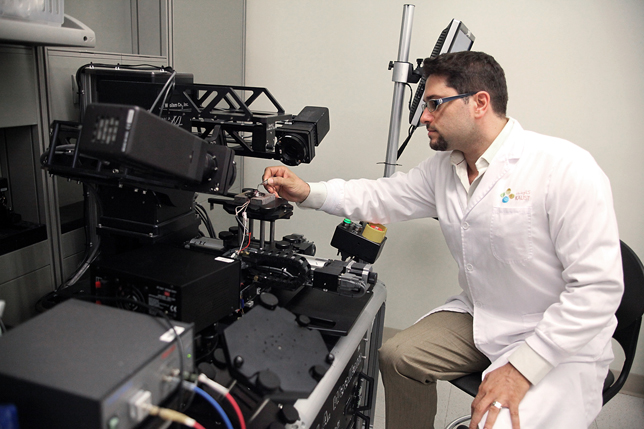New method used in production of faster plastic electronics

Dr. Aram Amassian, KAUST Assistant Professor of Material Science and Engineering
Dr. Aram Amassian, KAUST Assistant Professor of Material Science and Engineering, and a team of KAUST and international scientists have developed a crystallization process of organic molecules that has potentially wide-ranging applications in the electronics, pharmaceutical and food industries.
Their research and production of "strained organic semiconductors," a type of organic semiconductor, may lead to the creation of high performance, low-cost, flexible and transparent electronic devices and displays on large area substrates.
To produce the semiconductors, organic molecules are dissolved into a solution and the resulting liquid is spread on a flat surface using a squeegee-like contraption. The trailing liquid dries, leaving behind a remarkably well-ordered, highly continuous thin film with unusual structures and unique electrical properties.
Stanford Professor of Chemical Engineering Dr. Zhenan Bao discovered strained organic semiconductors several years ago, when she demonstrated that they were among the fastest plastic electronics at the time. Dr. Bao's research team wanted to understand how the process she pioneered created such an electronically useful crystal lattice. To do this, they sought the expertise of Prof. Amassian, who specializes in studying the formation of organic thin films for electronics and solar energy.
"Understanding how these remarkable crystals are formed can open up entire new fields of application which go well beyond electronics. In fact, the dissolution rate and bioactivity of pharmaceuticals or the flavor of certain foods depends on the type or form of crystal, also known as the polymorph," Prof. Amassian explained.
To record the process of crystallization, the KAUST team combined a tiny, bright X-ray beam produced by Cornell University's High Energy Synchrotron Source (CHESS) with high-speed X-ray cameras to shoot a movie showing how organic molecules form different types of crystals.
Their paper published in Nature Communications (doi:10.1038/ncomms4573) explains why the process can produce an ideal lattice: quick evaporation of the solution coupled with the nanoscale thinness of the liquid at the moment crystals grow plays a large role. Once the liquid film becomes thin enough to confine the crystallization process, the polymorph to be produced can be selected with unprecedented control.
Prof. Amassian and the KAUST team faced a number of challenges while working on the research, which took two years to complete. One was the production of the miniature, remotely operated "squeegee blade" used to drag the thinning liquid and produce crystals in the safety of an X-ray room.
"We had to get the design right and test it on-site at CHESS on a very tight schedule," noted KAUST postdoctoral fellow Dr. Ruipeng Li, who co-authored the paper.
The main technical challenge the researchers encountered was focusing the X-ray beam onto a small spot at the edge of the moving squeegee blade, and then firing the beam at intervals a few milliseconds apart as the squeegee quickly dragged the thinning liquid and crystallization began.
The high-speed X-ray camera took snapshots of the crystal polymorphs as they were being produced, and the researchers then reassembled the snapshots to create an animated movie showing the process of crystallization. The researchers also sought out high speed microscopy expertise from the Thoroddsen group in Mechanical Engineering to observe the crystal formation process.
While watching the x-ray movie, the researchers were surprised to find the crystals forming in a highly unusual sequence. The most common and stable polymorph of a crystal usually forms last in a sequence of polymorph crystallization. But this did not happen with the crystals formed by the "squeegee effect."
"We were stumped when the stable form appeared first, followed by the strained polymorphs," explained Prof. Amassian. "This pointed to an unusual effect – possibly confinement [thinning or thickening the liquid near the onset of crystallization] – similar to what is used in the pharmaceutical industry to control the formation of certain drug polymorphs."
The scientists confirmed their hypothesis by tuning the confinement conditions to produce different polymorphs, discovering that solvents with different molecular sizes also affected the formation of the polymorphs.
"We were pleased to demonstrate our initial hypothesis of confinement, but things got even more exciting when we showed the ease with which the crystal formation can be selected within the confinement window," Prof. Amassian said.
The solution-shearing method can produce continuous films of strained organic semiconductors over large areas, making it compatible with roll-to-roll manufacturing. Detailed knowledge of how to pack crystals with precise characteristics over large area substrates will help make strained organic semiconductors more practical for use in new types of flexible electronic devices.
In pharmaceutical manufacturing, drug activity depends upon precise control of compounds' crystal structures. Currently, pharmaceutically active compounds are produced by 3D confinement of molecules in a mesoporous polymer or glass medium to produce isolated nanocrystals which are not electrically connected. The new method allows formation of polymorphs over large areas in a roll-to-roll manner and with very well controlled topography and crystal orientation, which has the potential to benefit the production of pharmaceuticals.

